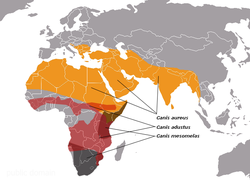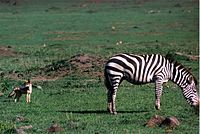
Jackal
Did you know...
This wikipedia selection has been chosen by volunteers helping SOS Children from Wikipedia for this Wikipedia Selection for schools. To compare sponsorship charities this is the best sponsorship link.
| Jackal | |
|---|---|
 |
|
| A black-backed jackal | |
| Scientific classification | |
| Kingdom: | Animalia |
| Phylum: | Chordata |
| Class: | Mammalia |
| Order: | Carnivora |
| Family: | Canidae |
| Genus: | Canis in part |
| Species | |
|
Canis aureus |
|
 |
|
A jackal (from Turkish çakal, via Persian shaghal ultimately from Sanskrit sṛgālaḥ ) is a member of any of three (sometimes four) small to medium-sized species of the family Canidae, found in Africa, Asia and Southeastern Europe. Jackals fill a similar ecological niche to the coyote in North America, that of predators of small to medium-sized animals, scavengers, and omnivores. Their long legs and curved canine teeth are adapted for hunting small mammals, birds and reptiles. Big feet and fused leg bones give them a long-distance runner's physique, capable of maintaining speeds of 16km/h (10mph) (just over 6 min/mile) for extended periods of time. They are nocturnal, most active at dawn and dusk.
In jackal society the social unit is that of a monogamous pair which defends its territory from other pairs. These territories are defended by vigorously chasing intruding rivals and marking landmarks around the territory with urine and feces. The territory may be large enough to hold some young adults who stay with their parents until they establish their own territory. Jackals may occasionally assemble in small packs, for example to scavenge a carcass, but normally hunt alone or as a pair.
Taxonomy and relationships
In 1816 in the third volume of Lorenz Oken’s Lehrbuch der Naturgeschichte, the author found sufficient similarities in the dentition of jackals and the North American coyotes to place these species into a new separate genus Thos after the classical Greek word θώς. Oken’s idiosycratic nomenclatorial ways however, aroused the scorn of a number of zoological systematists. Nearly all the descriptive words used to justify the genus division were relative terms without a reference measure and that the argument did not take into account the size differences between the species which can be considerable. Angel Cabrera, in his 1932 monograph on the mammals of Morocco, briefly touched upon the question whether or not the presence of a cingulum on the upper molars of the jackals and its corresponding absence in the rest of Canis could justify a subdivision of the genus Canis. In practice, he chose the undivided-genus alternative and referred to the jackals as Canis.
Oken’s Thos theory had little immediate impact on taxonomy and/or taxonomic nomenclature, though it was revived in 1914 by Edmund Heller who embraced the new genus theory. Heller’s name and the designations he gave to various jackal species and subspecies live on, though the genus has been changed from Thos to Canis.
Modern research has clarified the relationships between the "jackal" species. Despite their outward similarity, they are not all closely related to one another. The side-striped jackal and the black-backed jackal are close to each other, but separated from the other African and Eurasian wild dogs and wolves some six or seven mya. The golden jackal and Ethiopian wolf are part of a group also including the grey wolf, domestic dog and coyote.
Species:
- Golden jackal (Canis aureus)
- Side-striped jackal (Canis adustus)
- Black-backed jackal (Canis mesomelas)
- Ethiopian wolf (Canis simensis) – sometimes called the red or Simian jackal, but more often regarded as a wolf
Ancient use
The Ancient Egyptian god of embalming and the underworld, Anubis, was depicted as a man with a jackal's head. Today they are one of the more commonly seen animals on safaris, and are found outside of national parks and do well in human altered landscapes and even near and in human settlements.
Use in slang
All species of jackal are capable predators (all three hunt rodents and small mammals regularly, with the golden and black-backed species known to hunt poisonous snakes, large ground birds such as bustards, and mammals as large as young antelope). However, their popular image as scavengers has resulted in a negative public image.
- The expression "jackalling" is sometimes used to describe the work done by a subordinate in order to save the time of a superior. (For example, a junior lawyer may peruse large quantities of material on behalf of a barrister.) This came from the tradition that the jackal will sometimes lead a lion to its prey. In other languages, the same word is sometimes used to describe the behaviour of persons who try to scavenge scraps from the misfortunes of others; for example, by looting a village from which its inhabitants have fled because of a disaster.
- In Nonviolent Communication, "jackal language" refers to communication that labels, judges, and criticizes.



